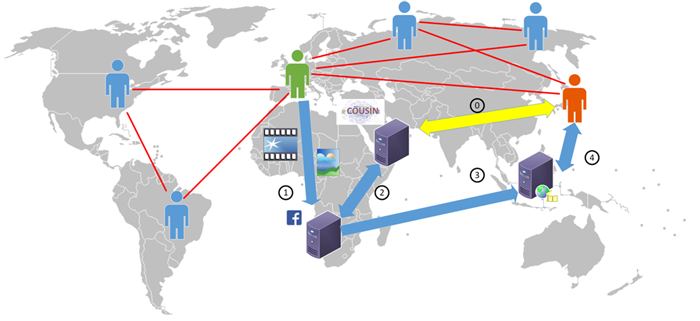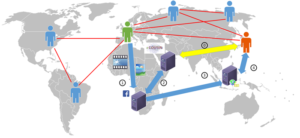IMDEA Networks

The social content revolution on the Internet
23 May 2013

Authors:
Autores:
Since the boom of the “World Wide Web” and up until recently, multimedia consumption over the Internet followed a very simple model. A user would use his PC to connect to a server and browse or download the available content from that same server. The last few years, emerging new technologies and devices have altered this traditional scheme of media discovery and delivery. The gigantic growth in popularity of Online Social Networks (OSNs), Content Distribution Networks (CDNs), video sharing websites, hand-held devices with multimedia capabilities and access to fast 4G/3G networks and finally peer 2 peer applications have shape-shifted the old centralized media dissemination model to a more distributed one, that often makes heavy use of wireless technologies.
The Internet has transformed into a primary means to access media content. A recent trend is the explosion of the global Internet traffic, mostly caused by an increase in video traffic. As a consequence, service providers are facing the huge costs related to updating their network and paying for traffic in order to cope with the demands of their customers. To this end, researchers are focusing on developing techniques that will either reduce traffic or distribute it more evenly throughout the day, reducing the peak demand. The key concept behind such traffic reshaping lies in the fact that part of this traffic can be predicted with relatively good accuracy and thus pre-fetched at a time that minimizes its impact on the network.
Today, a big portion of content is being discovered via OSNs such as Facebook or Twitter through recommendations and sharing. The separation of content discovery (OSNs) and content delivery (commercial CDNs, video sharing websites and lately OSNs) allows to obtain timely information regarding by whom, where and when a piece of content will likely be accessed. In the case of popular content, it is possible to obtain fine-grained information about the locality and quantity of traffic this content is expected to generate. Further, it is the only method that can provide some information regarding the future consumption of less popular content. For example, if a link is posted to the wall of an OSN user, it will probably be accessed when that user logs in to that OSN. In the time between the posting of the link and the user log in (i.e., the time when the link is uploaded, but the user is not yet aware of it), the content can be pre-fetched to the users’ device or a nearby cache.
The core concept of eCOUSIN is to investigate and implement techniques that will a) extract and b) take advantage of the information found in OSNs in order to optimize content delivery and as a consequence both reduce the infrastructure and operational costs of the providers and boost users’ Quality of Experience. Improvements to data dissemination will be achieved through content popularity prediction, pre-fetching of content, and/or accurate provisioning of bandwidth demands.

Schematic representation of the research carried out by eCOUSIN
An example is given in the figure above. In this figure, we can see a part of a social network of the “green” user, where red lines represent friend relationships.
-
Step 0: The eCOUSIN server continuously gathers information regarding the activity of the OSN users and their content access patterns.
-
Step 1: The user marked in green uploads a piece of media content (picture/video etc.) to the servers of the social network.
-
Step 2: eCOUSIN servers are notified about the content upload. Based on the information from step 0, the probability of each friend of the user marked in green to access the content is calculated. In this example, eCOUSIN has predicted that the user depicted in orange, located several time zones away will make a request for it in the near future.
-
Step 3: The content is pushed to the local cache of the interested user at a convenient time, before the predicted actual request from the user.
-
Step 4: The “orange” user consumes the content from the local cache, resulting in a good video quality for the user and minimal network resource usage.
The eCOUSIN architecture promises to enhance the Quality of Experience of end users (in many occasions the content will already be at their devices at the time they make request, during peak traffic periods, or even when they do not have network connectivity in the case of mobile devices). Also, we expect to greatly reshape the network traffic and reduce the peak traffic load, thus reducing costs for the ISPs while providing better service to the rest of the users.
eCOUSIN is an EU FP7 project with 9 partners from 6 different countries (France, Germany, Belgium, Spain, Italy, United Kingdom): two network operators, two vendors and manufacturers of telecommunication equipment, together with one research institute (Institute IMDEA Networks) and four universities. Its duration is 30 months, from November 2012 to April 2015. You can find more information at http://www.ict-ecousin.eu.


Recent Comments